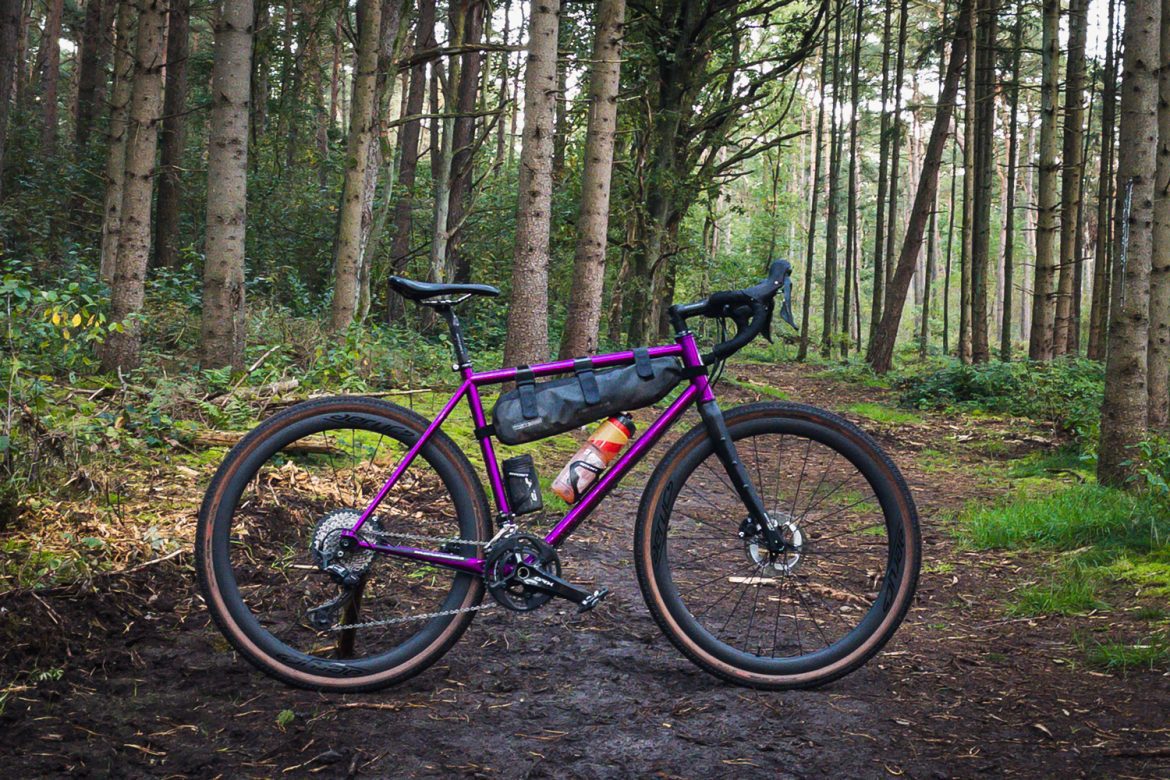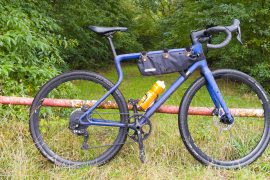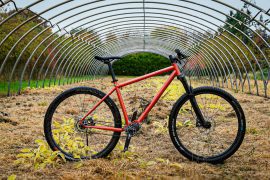Please Note:
At my request, Böttcher provided me with a test bike. I also received a lot of information from the Böttcher team and was able to visit the company headquarters in Heide. Therefore, this is advertising, but you know that...I can make it short: The Böttcher Evolution Gravel is a bike that I really enjoyed riding. All in all, I covered over 450km with the Evolution Gravel and was thus able to gain a good overall impression. Whether in the forest or on asphalt – it is very fast, quite agile, not too sporty, but not too comfortable either. It behaves pleasantly agile and direct off-road when I have to steer quickly and move the bike accordingly. On gravel or asphalt, it shows its touring bike genes and runs nice and straight. This directional stability is especially helpful at high speeds, and even with luggage and off-road the Evolution Gravel doesn’t show any weaknesses.
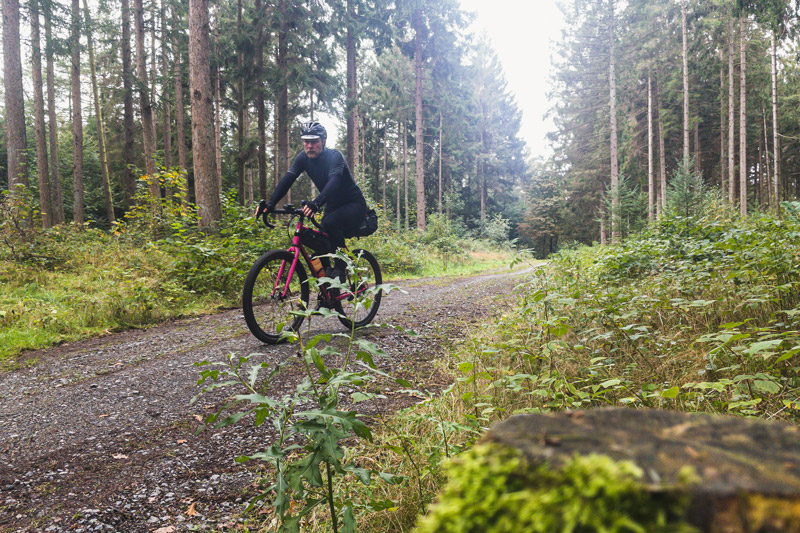
Evolution from the North
Böttcher – for me that was more associated with the trapezoidal frame bikes in front of the supermarket or the practical trekking bike for the Sunday tour. And where they sit and produce? No idea!
Then I met Olga and Michel from rausgefahren.de, who started their tour through and around the world on Böttcher Expedition travel bikes. Aha, so Böttcher can do touring bikes. And another look showed: not only that! They can also do “proper” touring bikes and sporty gravel bikes. And even better: they are located in Heide, only 100km away from me in the real north, in Schleswig-Holstein.
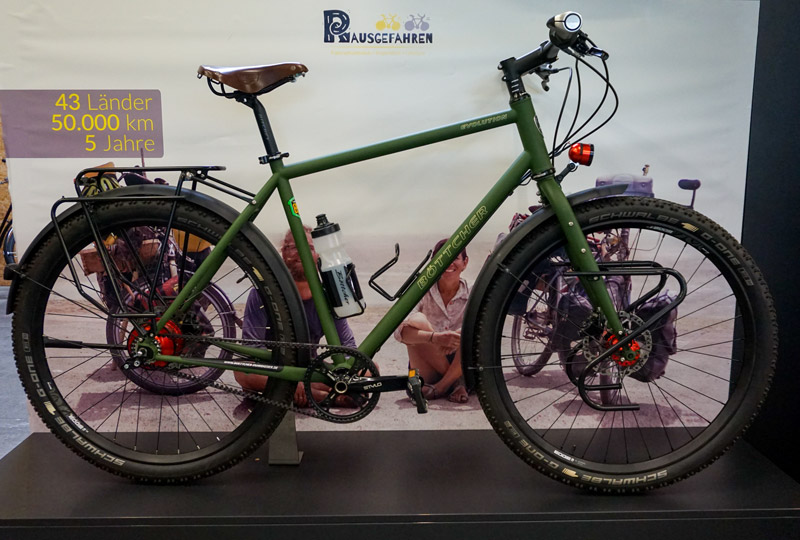
And that’s where they’ve been for over 110 years, producing bikes for everyday use, but also for travel and now also for the megatrend gravel.
Expedition is the name of the Böttcher touring bike: a solid bike for all the challenges of cycling around the world, with a steel frame, 26-inch tyres, Shimano 3×10 derailleur or Rohloff and rim brakes. What seems to me to have fallen out of time, nevertheless enjoys a high demand and brings many bicycle travelers safely through the continents.
More relevant for me, however, is the next logical step that Böttcher has on offer: the Evolution. And as the name suggests – evolution is part of the system here:
- The evolution of the touring bike towards a more comfortable touring machine on 27.5 inch rims with wider tyres, disc brakes and the option of a Pinion gearbox.
- The evolution towards a sportier trekking bike that is suitable for touring as well as training.
- The evolution towards a gravel bike with which you can whizz through the forest and over asphalt. And which, with little effort, becomes a touring bike for the next tour or a trekking bike for the daily commute to work.
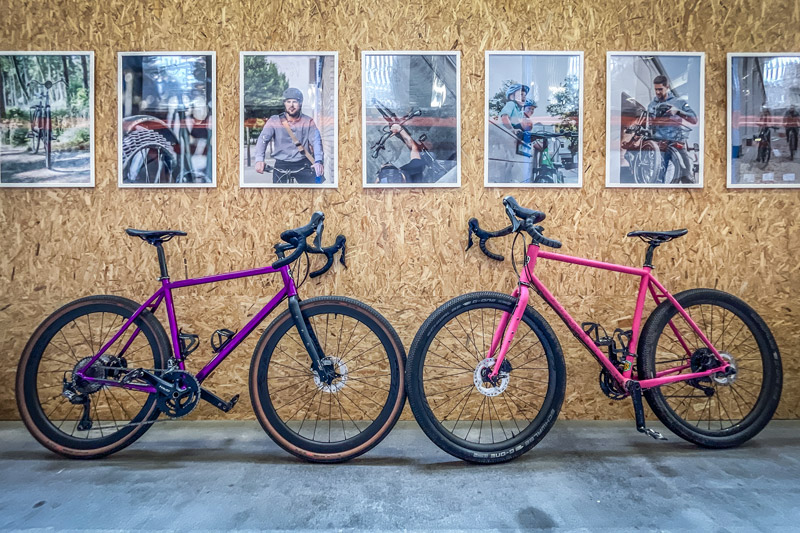
So the Böttcher Evolution was a “3in1” concept – depending on how the bike was to be used. And this also reflected an old Böttcher principle, namely to offer a bike that can do “everything”.
However, this has changed in recent years and Böttcher has of course recognised this development. And with the Evolution, it has reacted almost literally. While the Evolution Gravelbike (called Race) was based on the same frame as the touring and trekking version until last year, the Böttcher Evolution Gravel is available from this year as an independent gravelbike with adapted geometry.
Harry Brlek, Marketing Manager at Böttcher Bicycles describes it this way:
“The Böttcher Evolution is a thoroughbred touring bike with either 27.5″ or 29″ wheels. It is one of the few touring bikes that can accommodate tyre widths 60+. I would even say that there is hardly any other manufacturer with this individual choice for a Reynolds 853 tube set. As a further development of the Böttcher Evolution comes the Böttcher Evolution Gravel, which has been adapted even more uncompromisingly for gravel bikepackers: shorter rear triangle, higher chainstays, no eccentric, no subdivision of the chainstays for Gates belts and carbon fork. All changes that make the bike more appealing to the sportier crowd as a gravel bike.”
The Evolution travel line-up retains the original Evolution geometry, which is slightly more long-travel friendly, and is offered in XT, Rohloff and Pinion variants.
Frameset & Geometry
I usually do a comparison to other bikes of a similar type at this point, but unfortunately the Böttcher Evolution Gravel is not yet listed in the Bike Insights database. Therefore, I cannot make a data-based comparison with other bikes.
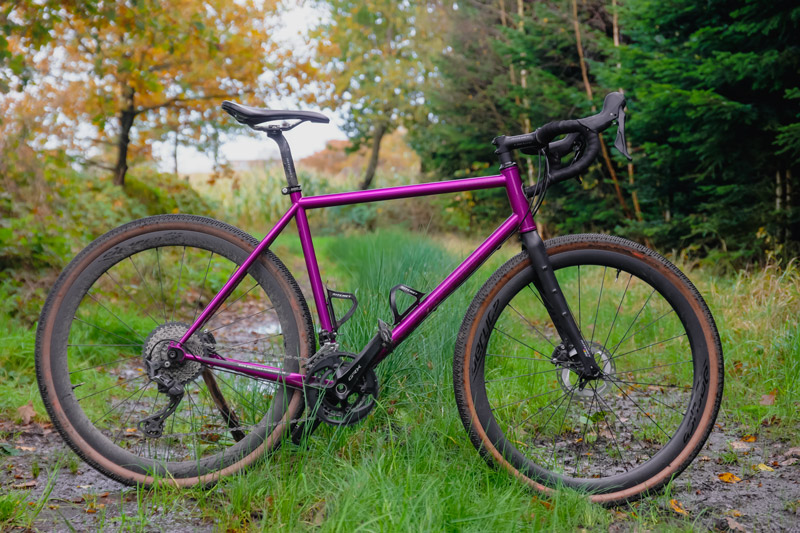
With the Evolution Gravel, the geometry has been optimised more for gravel/bikepacking. Böttcher has shortened the chainstay by 2 cm, which means more agile handling, and adjusted the seat tube angle to be 0.5 degrees steeper. In addition, the frame lock has been removed from this model and eccentric bottom brackets are no longer used. And the steel fork has been replaced by a high-quality Adventure Carbon fork from Ritchey.
In any case, the Evolution Gravel has many components from Ritchey, which I welcome.
No compromises were made with the frame material: Here, the makers from Heide rely on the high-quality Reynolds 853 steel. This is one of the Champions League of steel frames and makes it possible to build particularly resistant and at the same time light frames for the challenges of a big tour or a harder gravel.
Böttcher explains as follows:
“To design a frame with a high load capacity you need an appropriate steel alloy with high tensile strength. Manufacturers with a 25CrMo4 alloy in their product range came into question. This traditional alloy is characterised by a very high strength and, depending on the conification, a low net weight. Our idea of the wall thickness (conification) was 0.8 – 0.5 – 0.8mm in order to achieve an optimal ratio between stability, weight and damping from our point of view and experience.
The Reynolds 853 was originally developed for side impact protection in the car industry and was also used in the rally sector for roll cages. As the technical features and quality fitted, and the Reynolds name is highly regarded in cycling, we chose the Reynolds 853 tubing set.”
The frames are built in Europe, more precisely in the Czech Republic by Fort Frames s.r.o.:
“In Heide, the frames are powder-coated and assembled to order. The choice of colours and components is made according to the customer’s wishes and individually. After ordering, the bikes are coated and assembled according to the motto “One Man – One Bike”. All this happens here in Heide. So you can already speak of “Handmade in Heide”.”
As written, the carbon fork comes from Ritchey and has the necessary eyelets for bikepacking. Three on each side. The maximum take-up load of the fork is 3kg per side. Unfortunately, the frame is not designed to take a suspension fork. So if you need comfort here, you have to go for Redshift or other suspension stems.
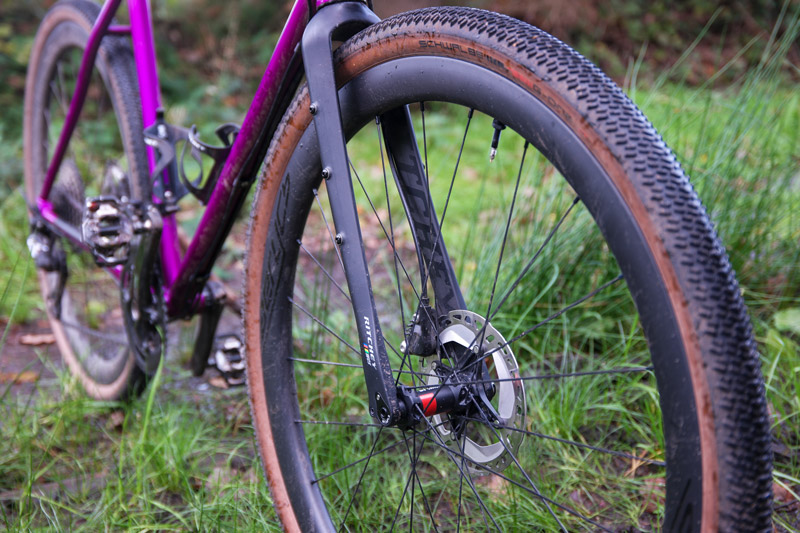
Speaking of weight: Böttcher is really far ahead here and offers a system weight of 150kg for the Evolution Gravel. This makes this bike predestined for heavier riders and for those who need to carry a bit more luggage.
The Evolution Gravel is available in three sizes: 48, 53 and 58.
“The frame height distribution is designed for body heights between 1.60m and 1.95m. By following the MTB sizes with 15, 17, 19, and 21″, we have adapted the geometries with a focus on the top tube and head tube length.”
Here are the geometries and specs of the Evolution Gravel (and the other Evolution models) for all sizes:

The Evolution Gravel is also available on request only as a frameset for self-assembly. According to Böttcher, the weight of the frame is 2,220g and that of the fork 445g (in frame size 53). All in all, less than 3kg, which is perfectly ok for a steel frame.
According to the manufacturer, the total weight of the Böttcher Evolution Gravel is 11.8kg for the build kit. I weighed the test bike, which differs slightly from the configurable bike in its equipment (e.g. different hubs) and came to 10.45kg including pedals.
That’s not particularly light, but if you choose a steel frame bike, the weight is less important. And in most cases, the most efficient way to reduce weight is to start with yourself, rather than with the bike 🙂
And as far as the colour is important: The test bike has the quite attractive “violet dormant” as frame colour. I think it’s really good, even though I’m more into muted colours.

But you don’t have to worry that you’ll have to choose “violet dormant”, because there are a total of 18 colours to choose from in the configurator. And if that’s still not enough, you are welcome to call Schleswig-Holstein and ask about other colour options, which will then be implemented individually on site in Heide. Incidentally, the paintwork is quite resistant. I also rode the bike with bags and where there are usually signs of wear, there were none on the Evolution Gravel. Bombtrack, for example, has a quite sensitive paint, where it is sometimes enough to ride once with bags without a protective film to leave marks.
One question reached me via Instagram: Is the Böttcher logo/badge on the front of the head tube always included, or can you opt out of it? Yes, you can also do without it and then it remains blank on the front.
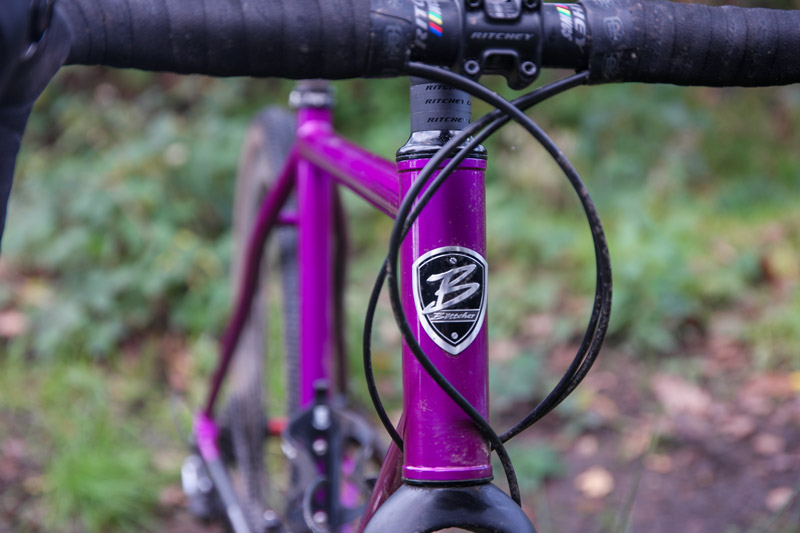
Equipment
The wheels
Depending on the configuration, the Evolution Gravel comes with a high-quality carbon wheelset. These rims come from the Hamburg-based carbon manufacturer Aerycs. Here the wheels are built by hand. The carbon rims are either handmade in Munich or baked in Asia according to Aerycs’ specifications.

On the test bike, the 700cc Aerycs Allround GCX Terra 40/40 were fitted. According to the manufacturer, they are best suited for gravel use and increase riding comfort. In fact, I have the impression that carbon rims provide even more propulsion with my riding style. In any case, I have a very pleasant feeling on the Evolution Gravel and the impression that these wheels make me faster.
Böttcher/Aerycs say:
“With our ALLROUND GCX TERRA | 40/40 wheels, the radial stiffness is about 10% lower than with our road wheels. This improves the damping behaviour of the rim and the bumps on the track are better absorbed. In this way, our ALLROUND GCX TERRA | 40/40 offer you maximum riding comfort on any terrain. The rim flanges and the rim base are additionally reinforced to protect against punctures.”
The rims have an inner/mouth width of 22mm and a width of 29mm. The weight per rim is 436g with a rim height of 40mm. Approved for tyres up to 62mm wide and of course tubeless ready. The system weight release is 120kg. This should be enough for most riders, but may be tight if you ride the bike off-road with luggage.
Someday I’ll allow myself a carbon wheelset, but the system weight must be at least 130kg, otherwise I’ll quickly destroy it again. But for reasons of riding comfort, it would make sense.
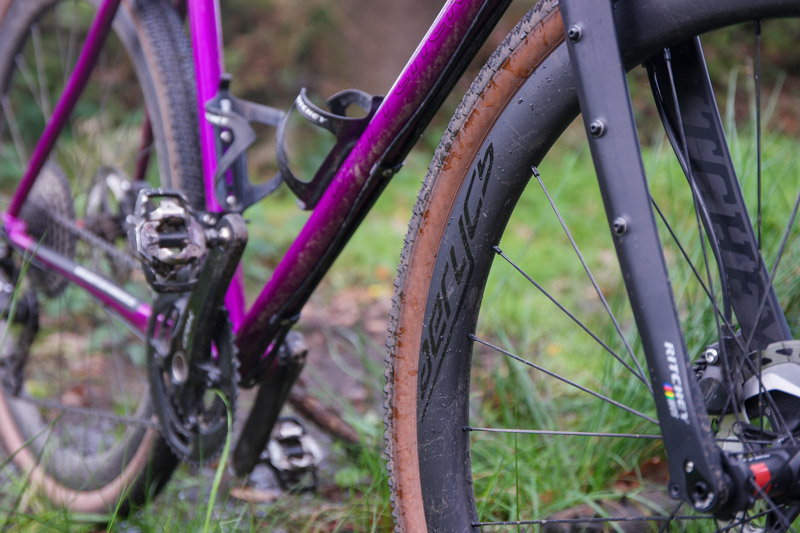
The Evolution Gravel wheels weigh 1,551g and are fitted with the tried and tested DT Swiss 350 hubs (straight pull). DT Swiss Aero Comp spokes are used here.
The carbon rims are only available in combination with the Shimano GRX 22 800 shifting system and the high-quality WCS Ritchey components. But then the bike also costs around 5,200 euros.

If you want something less, you can choose the Shimano GRX 22 600 version with Ryde Egde M30 aluminium rims with a 30 mm inner/mouth width and 34 mm width. Then the price starts at 3,900 euros.
The Böttcher Evolution Gravel is designed as a 28″/700cc wheel and accepts tyres up to a maximum width of 54mm.
The new Gravel model is fitted with Schwalbe G-One R tyres in a width of 40mm. I am basically sceptical about Schwalbe, as my experiences here have been rather negative. (Except for the Schwalbe Mondial in 26 inch and 50/55mm width. It’s really good on a touring bike and lasts more than 10,000 km without problems). So far, I have had no luck with the G-One models and, apart from a rather modest performance, I have always had punctures quickly. This was also the case on the first Böttcher test bike, which came with G-One Allround. Three punctures at once, which I couldn’t seal properly with Maxalami either.
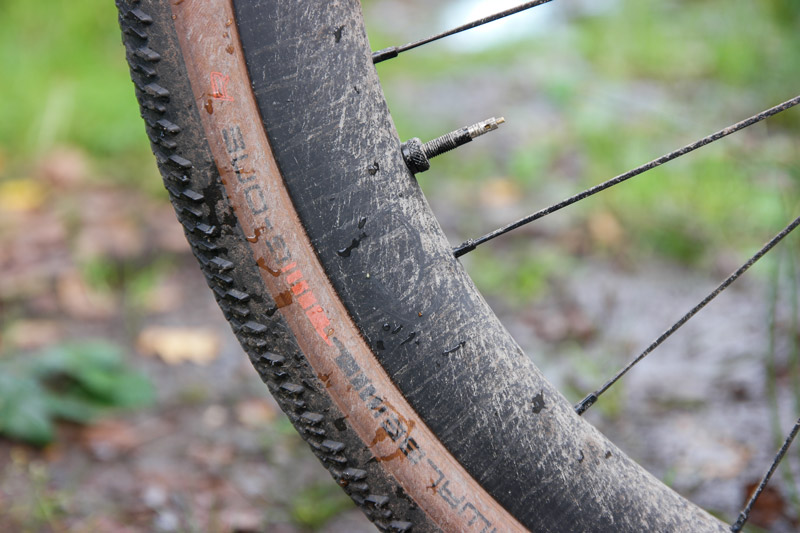
But the G-One R seem to be a different world, because I really like them. I ride them with about 2.5 bar and they are nice and fast on asphalt and have decent propulsion and grip in the forest, in mud and when it’s wet, surprisingly good grip. I can even go harder through the curve when it’s raining. And so far they’ve kept sealed, which isn’t always easy for me 🙂
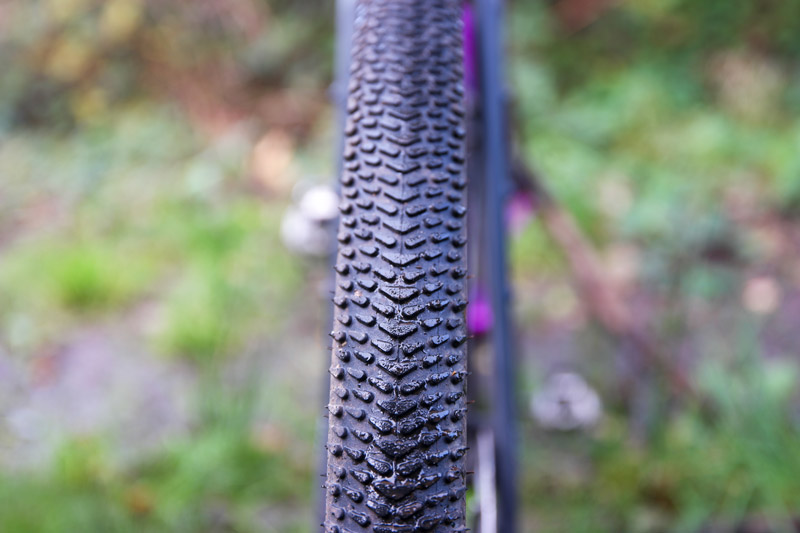
If the Schwalbe G-One Bite and Ultrabite also perform as well, I’ll be happy to put them on my wheels.
The gears & brakes
I already mentioned it above: The Evolution Gravel comes with the 11-speed Shimano GRX 22, either in the 600 or 800 configuration.
The 22 stands for 2-speed shifting, i.e. 2 cranks at the front. These are fitted (depending on the equipment) to a GRX 810 crank, with a size of 48/31.
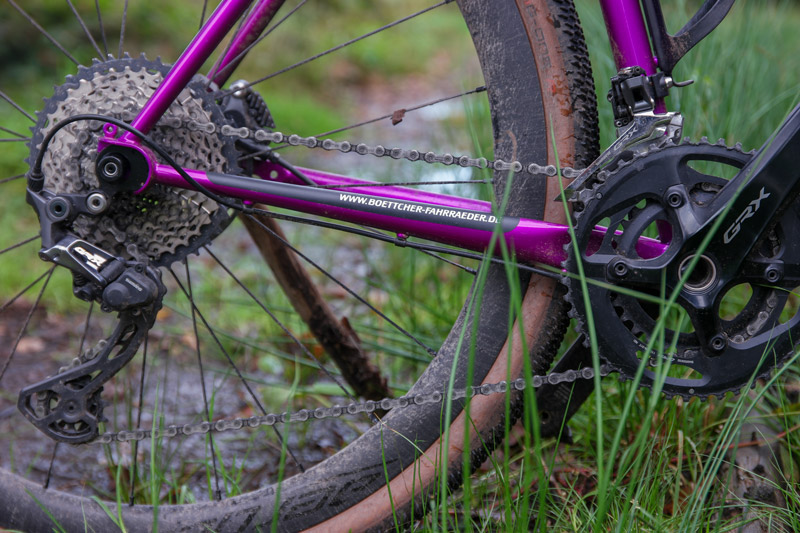
Together with the 11-34 cassette, this gives a range of 479% and a slight reduction can be used when going uphill. For fans of larger gear ratios – especially for off-road and with luggage: You can also add a little more to the rear, because the GRX also does larger sprockets. But that’s another discussion 🙂
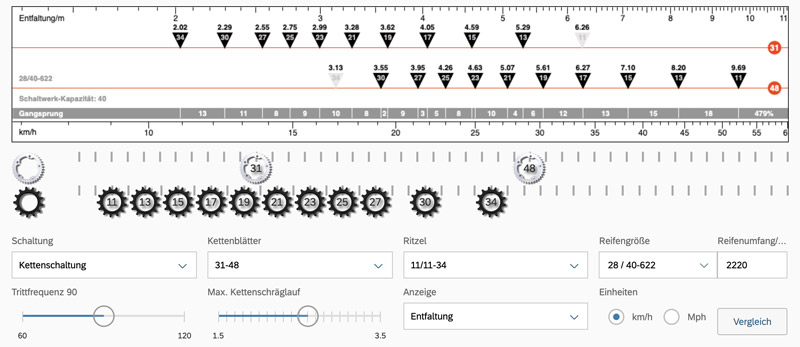
I asked Böttcher about the reasons for the current focus on 2-speed gears and why they don’t offer 1-speed gears on the Evolution Gravel:
“Here our experience also plays an important role. The bandwidth of the 2-speed shifting is much higher than with the 1-speed GRX. Furthermore, the gradation of the cassette can be selected more finely than with 1-speed. The gear ratio of the 2-speed version is needed as soon as luggage is added.”
There is nothing to complain about with this gear system. It works precisely, easily and also under load. As an SRAM rider, I always have to get used to shifting with the brake handles, but that goes quickly.
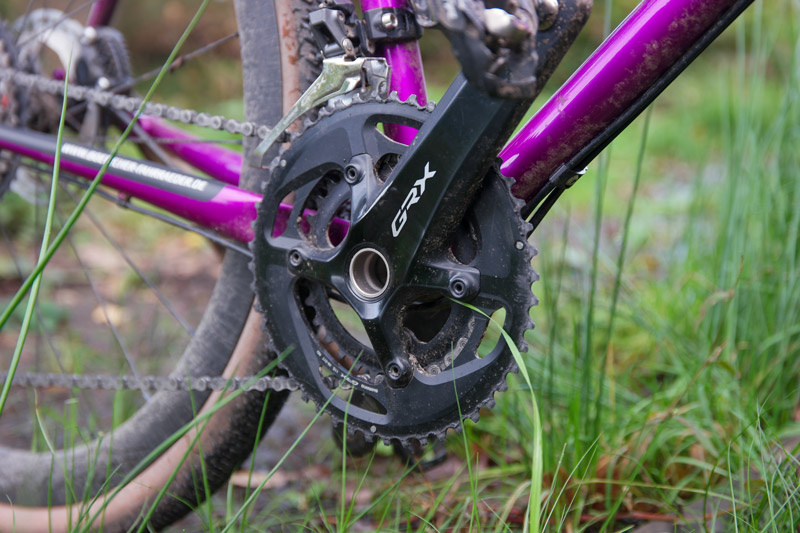
And if you don’t want the GRX, you have to buy the frameset and assemble it yourself. Or call Heide and they will definitely have a customised solution. But there are apparently more variants planned in the future:
“Currently we are also thinking about the Campagnolo Ekar 1×13 and Sram eTap.”
Braking is also done with the hydraulic GRX on Icetech 160mm discs. This is perfectly adequate and the braking performance is also good.
The handlebars, stem and saddle
On the Evolution Gravel model with 800 GRX equipment, Böttcher uses the high-quality Ritchey WCS parts. The model with GRX 800 is equipped with a Ritchey WCS C220 stem. The steering is done with the Ritchey WCS Butano handlebar in a width of 440mm.
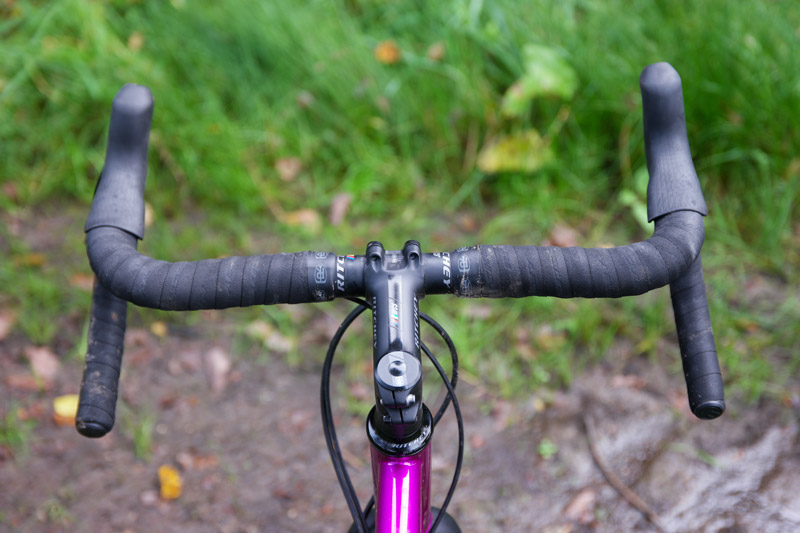
The seat post is also from Ritchey: the WCS 2-Bolt is used here. The saddle is from PRO and is the Turnix Team model with carbon frame.
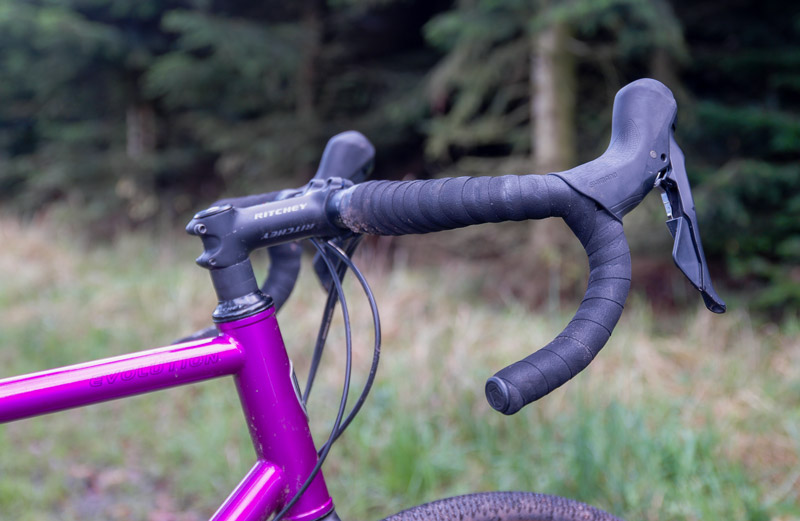
And because there was also a question: The bottle cages are also from Ritchey and are called Comp V2.
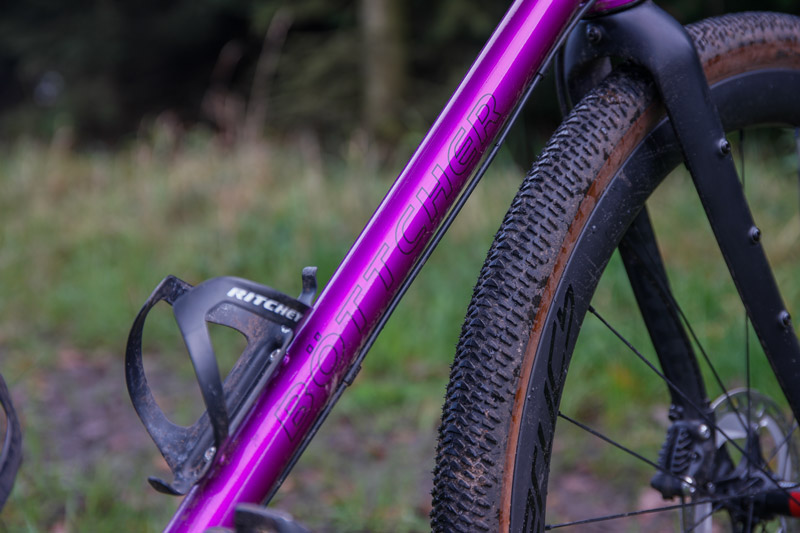
Categorisation & Conclusion
Welcome to Martin’s big Allroad bike review
Over the last few weeks I’ve been thinking a lot about how I can actually classify all the bikes I test.
Of course, this is not easy, also because the variety of types, applications, categorisations and trend names make it almost impossible to structure it. Nevertheless, I have given it a try. Under the umbrella term ” Allroad bike” (thanks to Jan Heine and his very readable book “The Allroad Bike Revolution“) I have formed three categories, which of course overlap and thus also have things in common:

- Performance & Race: Some of the bikes come from the road bike/crosser sector and/or are inspired by it. Especially racing cyclists who switch to gravel find pleasure in these very sporty bikes, which are primarily intended for competitive use.
- Leisure & Everyday Life: Here I see the bikes that combine the sporty and the relaxed and with which you can go almost anywhere without thinking much about it. Yes, here we are mainly talking about the classic gravel bike as a great offer to all those who don’t want to worry about the ground anymore, but just want to ride.
- Travel & Adventure: Yes, even the daily commute to work can be an adventure, but in this category I see all bikes that are suitable for almost all terrains, whose roots lie more in MTB and that make off-road, bikepacking and bike travel possible in all variations.
There’s plenty to argue about and discuss. And while you’re thinking about it or already typing indignantly, I’ve put all the bikes I’ve tested so far in this category:

From my point of view, the Evolution Gravel is mainly in the intersection of leisure&everyday and travel&adventure. So it’s a gravel-travel bike, but it also appeals to riders who like to ride more sportily (hence a bit of Performance&Race).

Conclusion Böttcher Evolution Gravel
The Böttcher Evolution Gravel is a very good example of how a traditional company that is over 100 years old can, with the right people, some courage and careful observation and listening, build a bike that is a very attractive proposition in the growing market of gravel bikes.
Böttcher could step out of the shadows of their tradition and into the public eye and do it like vsf, who in a similar situation have made a very good pitch with their gravel bike.
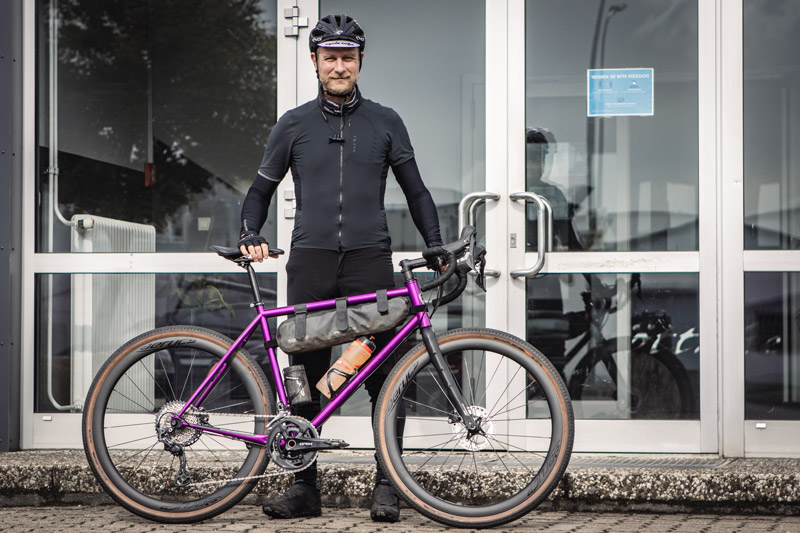
The Evolution Gravel will be fun for anyone who appreciates and loves speed and agility on a bike, but who also wants to keep all options open for bikepacking. With a system weight of 150kg, it’s certainly prepared for anything.
I particularly like the fact that the production takes place in Europe with high-quality materials and that a large part of the production (design & development, marketing, frame coating, assembly) takes place in Heide in Schleswig-Holstein.
For this, I find prices starting at 4,000 euros quite justifiable.
So if you have the chance, you should test ride the Böttcher Evolution Gravel. And if you have any further questions, feel free to post them in the comments. I’m sure Böttcher will check in here from time to time and can answer them.

